17 Nov Horsham’s Mystery Princess
Nur Begum’s journey from the Palaces of Lucknow to the Mystery Princess of Horsham
The story of Nur Begum is one of those little fragments of history that slips through the cracks of time and lies quietly forgotten. A lady who was born to privilege and aristocracy in India, being buried in a quaint English town and adopted as its “Mystery Princess”, with her grave becoming celebrated local landmark, was a story that I had a great time exploring.
Nur Begum is buried in Horsham, a small market town of medieval houses and cobbled streets about an hour’s drive from London. Horsham’s central building is the eight-hundred-year old St Mary’s Church ringed by a picturesque graveyard that has long ceased to be used. It is here that Nur Begum is laid to rest; her grave instantly recognized as the only one among twelve hundred that does not face east but is aligned south instead, towards Mecca.
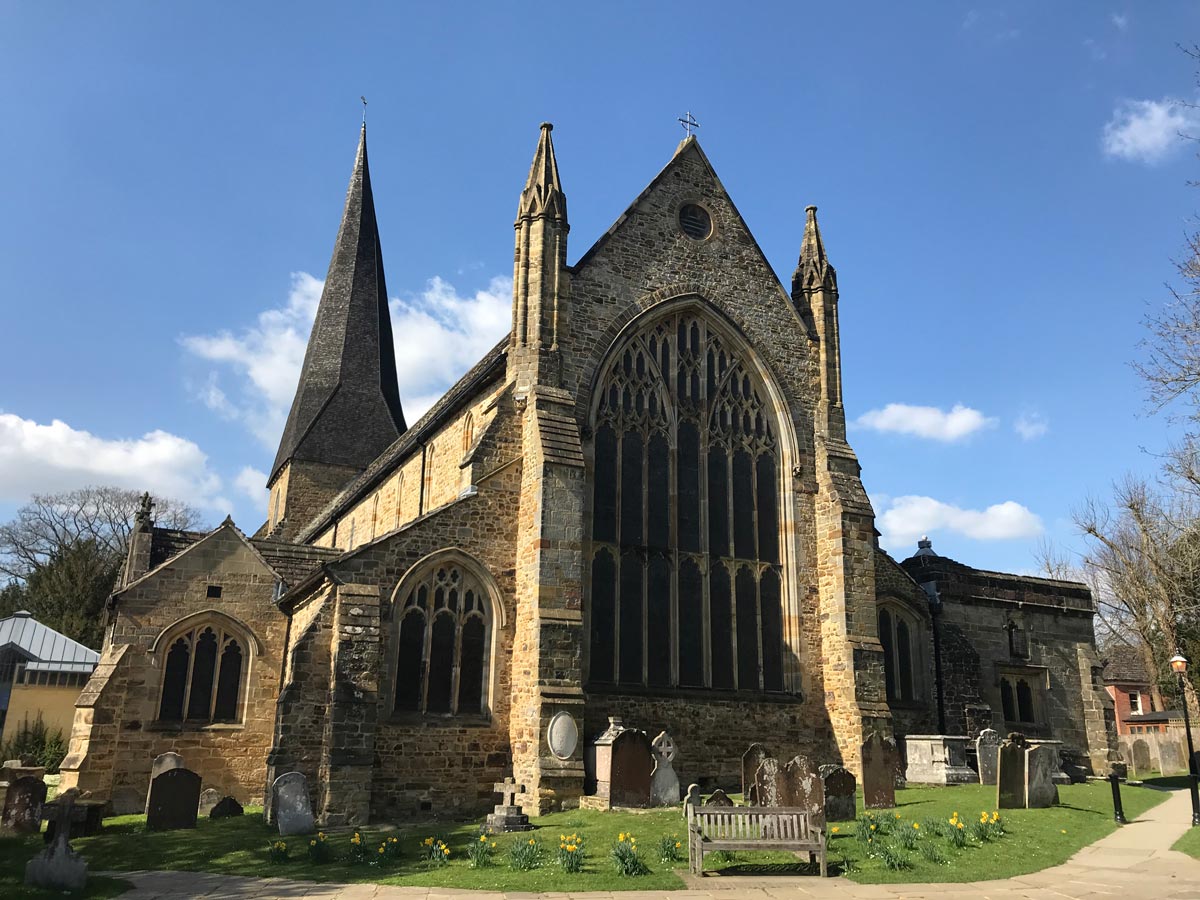 The eight hundred year old Saint Mary’s Church ; Horsham’s oldest building
The eight hundred year old Saint Mary’s Church ; Horsham’s oldest building
Nur Begum is folklore in Horsham. History books mention her as a local legend, and even the man behind the counter at the neighborhood pub immediately knew what I was talking about when I mentioned my reason for visiting. I had stumbled across Nur Begum’s story while researching the early European mercenaries who had made their fortunes in India. Nur Begum had married one of them, the dashing French mercenary Daniel De Boigne (more on him later). And now, barely a few months after I had first heard of her, here I was at her grave in this rural corner of England taking photographs of her daffodil-fringed tomb with the legend “ Benoit (Bennett), Persian Begum, 4 Jan 1854, wife of celebrated French adventurer” engraved upon it.
 Nur Begum’s grave, surrounded by smiling daffodils, is the only grave that faces Mecca
Nur Begum’s grave, surrounded by smiling daffodils, is the only grave that faces Mecca
I had left London earlier in the day, driving south amidst Surrey’s rolling hills, which my navigation system aptly described as “an area of outstanding natural beauty”. My appointment was with Jane Gorrie, an administrator for Horsham’s Saint Mary’s Church who said she would leave the church doors open for me to enter whenever I arrived. I parked my car at Horsham’s city center and walked towards the soaring spires of the church which dominated the skyline. Saint Mary’s was built beside the winding River Arun that flows through town, its grounds sloping down to the river’s edge. It was a bright spring day and I was stiff from the long drive, so I decided to unwind sitting on the wooden benches besides the gurgling river and watching the swans waddle past. A plaque beside the benches was engraved with this poem:
The People’s Garden of Remembrance.
The kiss of the sun for pardon,
the song of the birds for mirth,
one is nearer God’s heart in a garden,
than anywhere else on earth.
Nur Begum, or Nur Baksh (1773-1854) was born to an aristocratic family in Delhi, a world away from Horsham. Her Persian father was an officer in the cavalry of Mughal emperor Shah Alam and her family was unusually progressive for its time. Nur Begum was educated and fluent in English. Her sister Bibi Faiza Baksh, older to her by eight years, was married to Major William Palmer, Secretary to Warren Hastings, the British Governor General of India. While Nur had left for England with her husband General Benoit De Boigne, her sister Faiza remained in India living with her son William “King” Palmer, the founder of a prosperous Hyderabad firm, Palmer & Co*
Thanks to the excellent archives of the British Library in London, we know what Nur Begum looked like. The library has a portrait of William Palmer, painted by Johann Zoffany, that features Palmer in a red military coat, with his wife Faiza Baksh on his right, and her sister Nur Begum on his left. William Palmer’s children and some female attendants complete the group. Nur Begum is fair complexioned and pretty, and given the intimacy of the scene, obviously close to her sister’s family.
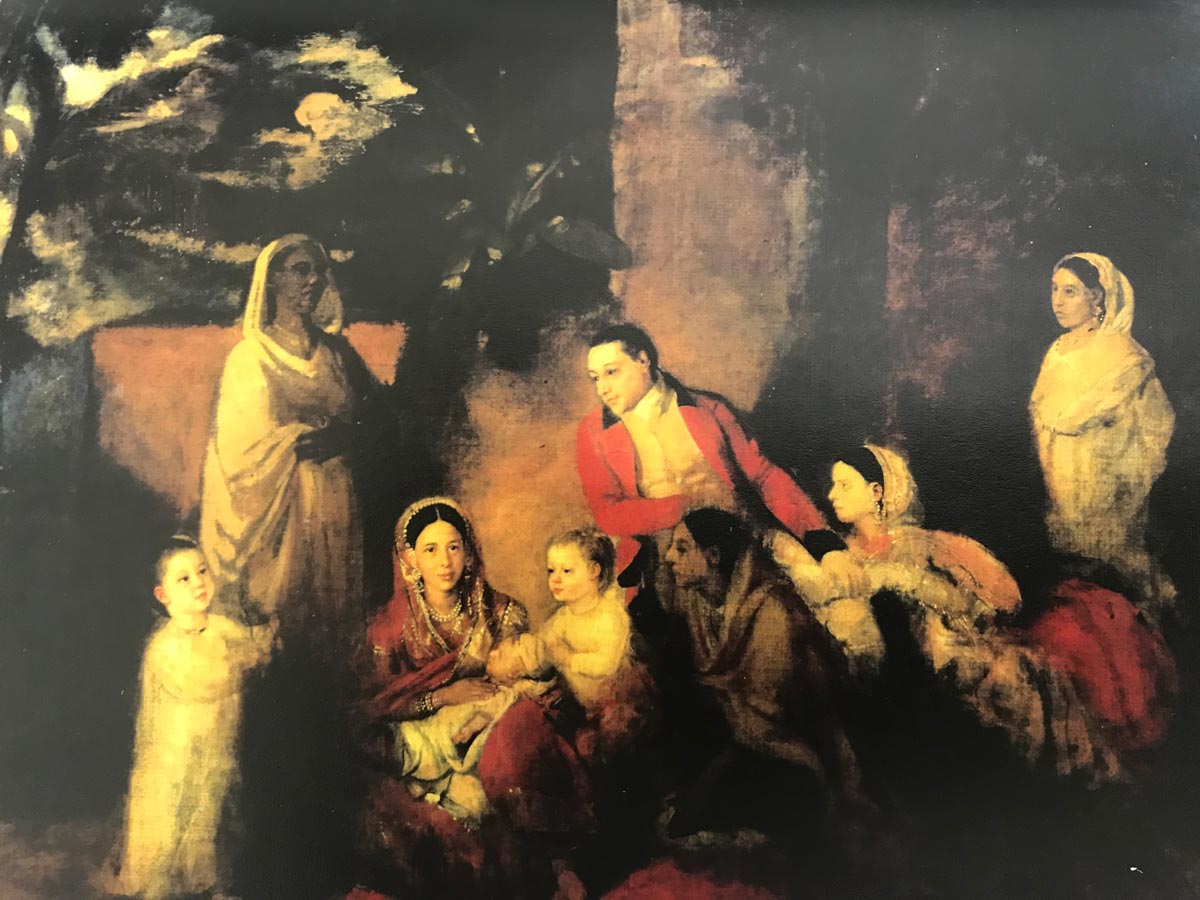 A portrait of William Palmer and family at the British library in London, which also features a pretty and fair complexioned Nur Begum
A portrait of William Palmer and family at the British library in London, which also features a pretty and fair complexioned Nur Begum
When Nur was just nineteen years, she married the successful French mercenary and adventurer General Benoit de Boigne. They had met in Delhi, introduced by De Boigne’s good friend Claude Martin, the founder of La Martiniere schools. De Boigne was already thirty-eight at the time and had earned his fortune as Commander-in-chief of the Maratha armies of Mahadji Sindhia. The marriage took place in Delhi in 1792, after which the couple shifted to Lucknow where De Boigne had started a business. Here two children were born to them; a girl, Banu, and a boy, Ali Baksh. In 1796, after eighteen years of active service in India, De Boigne decided to pack his bags and return to England accompanied by Nur Begum and the two small children. As Nur left her country for good, still a young woman of twenty-three, I wondered whether she was excited to embrace a whole new world. Was she happy or nervous? willing or unwilling? All we know is that Nur Begum remained uncomplaining throughout her life, stoically accepting the cards that life dealt her, and entirely devoted to her two children.
De Boigne was a wealthy man when he landed in England. The family settled in a well appointed house on Great Portland Street, and De Boigne wasted no time networking himself in to London’s society. The children were baptized, and their names changed to Charles Alexander and Anna. Nur Begum was given De Boigne’s mother’s name Helene, and, as a surname, his own name “Benoit”, anglicized to “Bennet”; Helene Bennet. But despite these various adjustments, things did not work out. De Boigne’s ambitions were not satisfied with his “Indian marriage” and he became infatuated with a seventeen year old French girl Adele D’Osmond…“pretty as an angel, with a mass of blonde curls, dazzling white skin and great limpid dark eyes which gave her a deceptively soulful expression”**. Adele was from a royal Normandy family, rich in lineage though penniless, and when De Boigne met her at a party in Brompton Square he was already forty-seven years old. Within a matter of weeks De Boigne proposed to Adele. The fact that he was already married with two children was “temporarily concealed”. Nur Begum was shunted out to a house in Enfield, a village near London, “retired to live quietly and respectably”. A few eminent London lawyers, who knew of the situation, offered to take up her case and help her legally laying claim to De Boigne’s vast wealth, but she declined it on account of her children.
Benoit De Boigne married Adele on June 11th, 1798, at the French Chapel in London. Nur Begum’s marriage had lasted just six years, and she was still a youthful twenty-five. As a further blow, Nur was also separated from her beloved children. Her daughter Banu (or Anna) died very young at fifteen, and her son Ali Baksh (or Charles Alexander) was taken from her and sent to a boarding school. She wrote long, yearning letters to him, enquiring about his health and sending him silk handkerchiefs as gifts. On his part, Charles seemed a dutiful and loving, if distant, son, writing that he was “particularly attentive to the best mother. I love, respect and esteem her…”.
As Helene Bennet, Nur lived alone in England for the next fifty-six years till she died at the age of eighty-one, outliving her precious children as well as her husband. She took what was given to her by De Boigne; a house in the countryside and a bank deposit that yielded an income of £300 a year, and she lived out her years in the village of Lower Beeding, close to Horsham, in a house rather grandly titled “Great Ground House” though it was little more than a cottage. Nur hired a personal maid to look after her, Mrs Bugden, with whom on Saturdays she would ride over to the Horsham church in a pony cart. The Horsham townspeople had got used to seeing their “mystery princess” every week. Mrs Bugden remembers her mistress wearing magnificent rings, smoking the hookah and being generous with the poor.
In all her years in England, there is only one record of Nur Begum being visited by a person from “back home”; the Persian author and traveller from India, Mirza Abu Talib Khan Isfahani (1732-1806), met Nur Begum around 1800 and wrote about her in his books. To him, Nur Begum appeared virtually English, dressed in British style and with very ‘English’ children. He believed that she had settled in England “out of devotion to her children, not love for her husband”.
Nur Begum died on December 27th 1853 in North Street, Horsham, not far from St Mary’s Church. A few days later, on January 4th, 1854, her body was lowered into this grave aligned towards Mecca, before which I was now standing. Nur’s journey was complete; from the palaces of Delhi and Lucknow to St Mary’s Church in Horsham.
 What would Nur Begum have contemplated, sitting on these pews
What would Nur Begum have contemplated, sitting on these pews
As I was taking photographs of Nur Begum’s daffodil fringed grave, I heard a voice “you must be Adil”. It was Jane, the church’s administrator, with whom I was due to meet. True to her promise, Jane had left the church door open for me and together we entered the hushed, cool, vaulted interiors of Horsham’s oldest church, a building where people have worshipped God for eight hundred years.
Jane was the perfect insider-guide, pointing out the wooden pews where Nur Begum may have sat and all the original church features she would have recognized; the blue-painted ceiling that has remained unchanged since the sixteenth century, the somewhat ungainly tomb of Thomas De Braose of the original family of nobles that had governed the area, and finally, saving the best for last, the vestry.
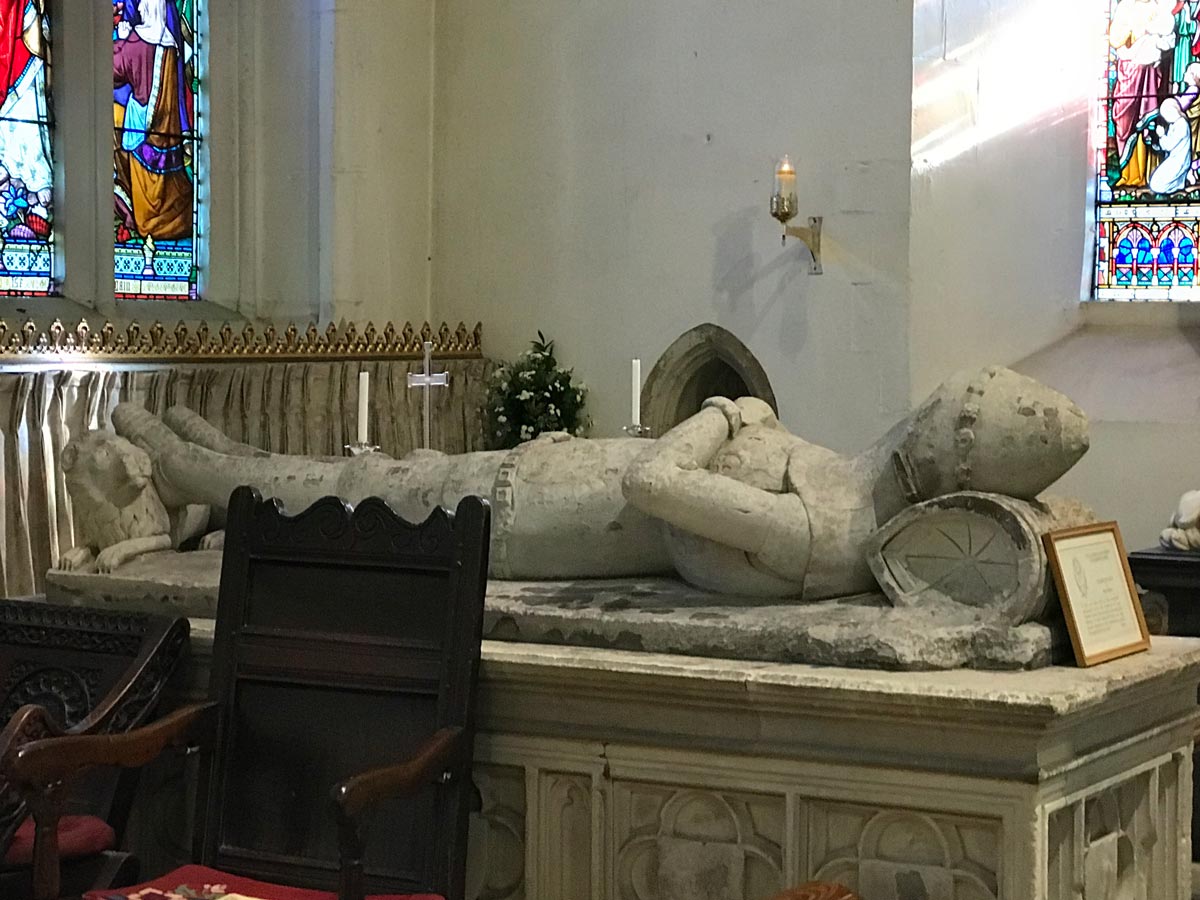 The Tomb of Thomas De Braose, who died as early as 1395 ; Nur Begum would have walked past him
The Tomb of Thomas De Braose, who died as early as 1395 ; Nur Begum would have walked past him
The vestry is where the priest’s ceremonial robes and sacramental wine are stored. I had never visited a church vestry before, and opening its thick wooden doors was like releasing a trap-door in to the past, full of promises of the discoveries that lay concealed behind it.
I was fascinated by this part of the church. The door was of thick oak studded with iron, with the ancient locks still working flawlessly. I tried them myself, turning the key to lock and unlock the door with the time-worn metal knobs sliding and clanging into place. Jane reminded me that what I was handling now had been touched by human hands for hundreds of years. I wondered whether Nur Begum had visited the vestry and turned these locks like I was doing now. It is unlikely she did. This section of the church was used as a prison for “Lollards”, considered heretics in the middle centuries as they adhered to a different branch of Christianity. The church’s brochure somewhat elegantly described it as “a place of detention for religious recusants”. I doubt whether Nur Begum had entered!
 The magnificent eight hundred year old original door to the vestry, with the original long key on top; like opening a trapdoor in to the past
The magnificent eight hundred year old original door to the vestry, with the original long key on top; like opening a trapdoor in to the past
Jane and I exited the church together, in to the fading sunlight. We stood under the tall steeple discussing the amazing life of Nur Begum, her adoption as Horsham’s local legend and the magnetic draw of her grave as a must-see landmark. I walked across to Nur Begum’s burial place again, as the sun set behind the church, and placed my hand on her grave one last time in a gesture of remembrance.
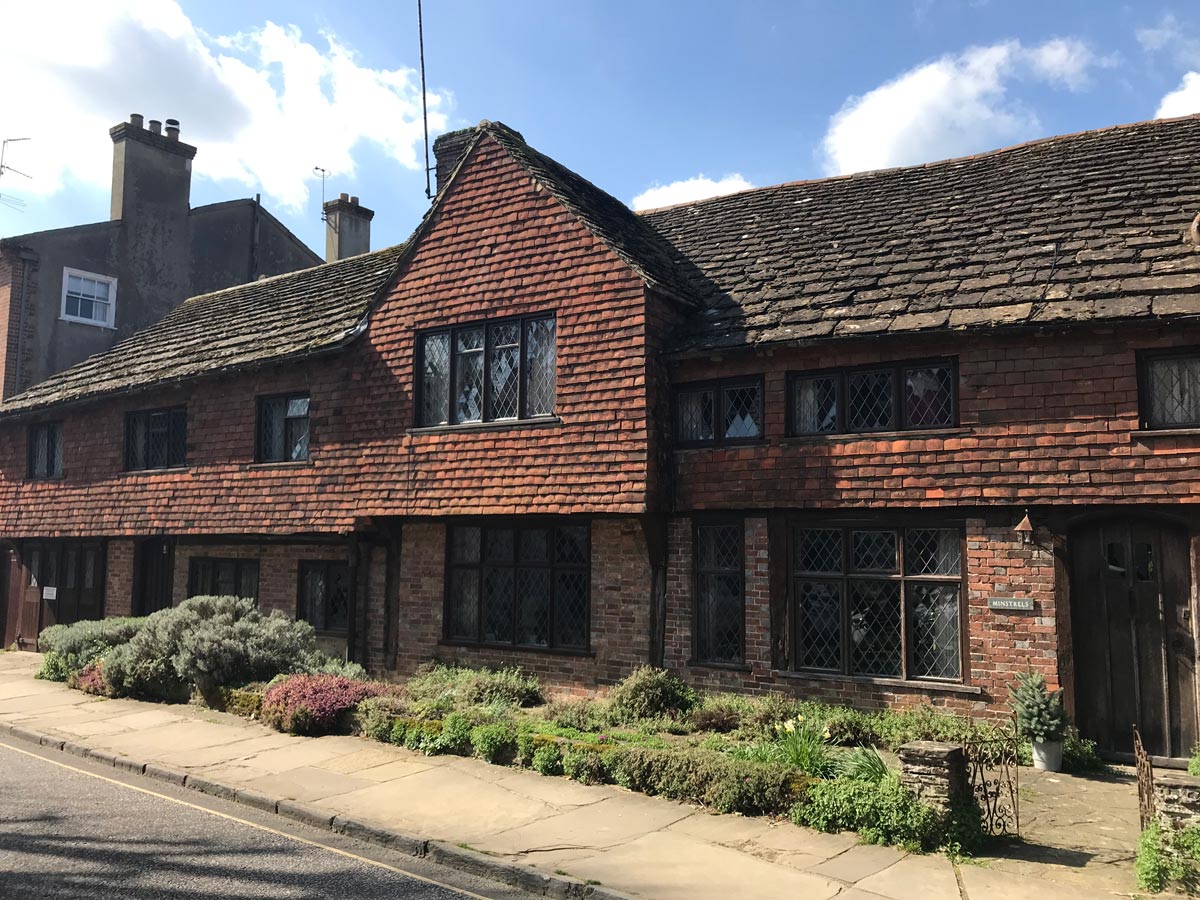 A typical century-old Horsham house that dots its historic city center
A typical century-old Horsham house that dots its historic city center
*“Fountain of the Elephants”. By Desmond Young. Page 100
** Fountain of the Elephants”. By Desmond Young. Page 201
** Fountain of the Elephants”. By Desmond Young. Page 201
The Mixed Legacy of General Benoit De Boigne
In the pretty Alpine town of Chambery in south-east France, the top attraction is the soaring Fontaine des Elephants or Elephant Fountain. It is built to impress, with a height of sixty feet and an eye-catching design of four elephants facing different directions. The fountain honors general Benoit De Boigne (1751-1830) who had made his fortune in India and chose to bestow his considerable wealth on this town where he was born.
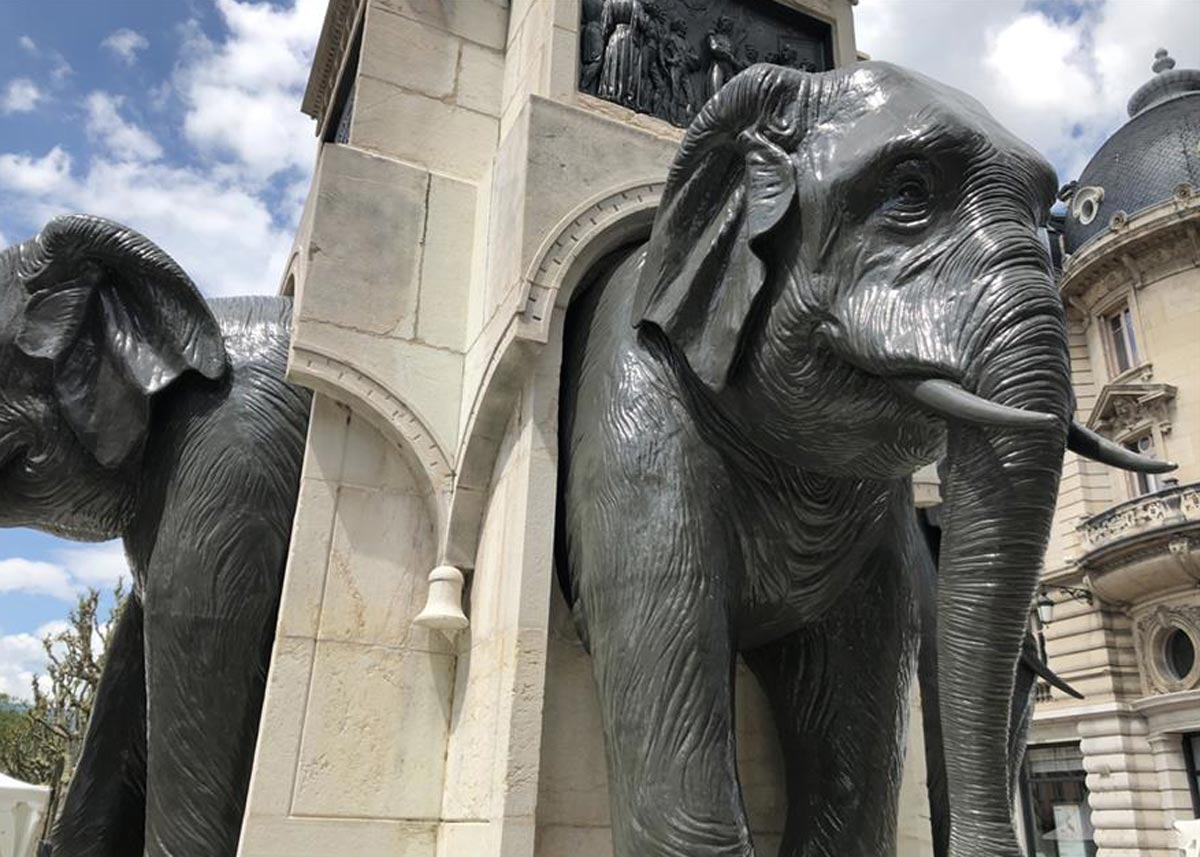 Chambery’s Fontaine des Elephants ; built to honor the town’s most famous benefactor
Chambery’s Fontaine des Elephants ; built to honor the town’s most famous benefactor
A lot has been written about Benoit De Boigne. You could view him as a super-successful benefactor and charity provider for his hometown. Or you could see him as morally decrepit, unwilling and unable to honor his personal responsibilities. Whichever way you look at it, De Boigne was a remarkable man who had lived an extraordinary life.
Born in Chambery as the son of a fur trader, De Boigne was bitten by the adventure bug early in life, seeing his father travel the world to stock his shop with exotic furs and animal pelts. At an early age, De Boigne left home to try his luck in the wider world. He joined the French army for a few years, then made his way to Russia, was taken prisoner by the Turks, became a slave in Istanbul and finally landed in hot, humid Madras in 1778. He was not immediately welcome. The British Governor in Madras, Sir Thomas Rumbold, considered De Boigne a French spy. There were no jobs available for him, and De Boigne was forced to set up as a fencing-master. Eventually, with the Governor overcoming his suspicions, De Boigne was allowed to join the Madras Native Infantry as an ensign. Such a junior post was galling for a man who was a captain in the French army and major in the Russian army, but he stuck it out. Within two years however, De Boigne was forced to resign even from this humble post for “taking undue liberties with the wife of a brother officer”. He decided to dump Madras for good to make his way to Calcutta and then to Lucknow.
In Lucknow, De Boigne became fast friends with his fellow Frenchman Claude Martin and his fortunes changed for the better. Martin, whose legacy includes the La Martiniere schools which he established, was the influential chief adviser to the Lucknow nawab and he helped his friend start a flourishing trading business in cloth and indigo. In time, the ruling Maratha strongman Mahadji Sindhia, impressed by De Boigne’s military track record, invited him to join his army as a general and De Boigne jumped at the chance. He negotiated a salary of ten thousand rupees a month with perks, and made two demands; first, that he would not have to fight the English, and second, that his troops be regularly paid. This was a smart move, getting him the unflinching loyalty of his men, and De Boigne went on to lead the Maratha army with distinction for five years. Eventually, in 1796, after eighteen “strenuous years in the hot sun”, he decided to quit India for good and return to Europe. By now, De Boigne was a rich man worth half a million pounds sterling. He was also a family man with a wife and two children.
It is this next chapter of De Boigne’s life that raises questions about his moral character. Within no time in London, De Boigne left his wife Nur Begum, emotionally abandoned his two young children, became infatuated with a French girl old enough to be his daughter, and married her while hiding the fact that he was already a family man. The second marriage was a disaster from the start. His new wife, Adele, accused him of having an “ungracious personality”, abusing and insulting servants and guests, habitually taking opium in large quantities that “paralysed his moral and physical faculties” and being insanely jealous “perhaps natural in the mind of a man of his age”.*
Ultimately they separated, with Adele dividing her time between the social circles of Paris and London while De Boigne retired to his native Chambery where he made much of charitable works, “building two hospitals, a lunatic asylum, an institute for teaching trades to young girls, an almshouse, a college and a public library”. Many honors were bestowed on him, as De Boigne regaled adoring locals with tales from his remarkable life. Meanwhile, in a small village in Surrey his first wife Nur Begum quietly lived a modest life, barely making ends meet.
* Page 149. “European Freebooters in Moghul India”. By Lester Hutchinson. Published by Asia Publishing House, London
Adele; the girl who knew her mind
The rushed marriage between seventeen year old Adele D’Osmond and forty seven year old Benoit De Boigne was less an oath of love and togetherness and more of a formal business arrangement. It included a pre-nuptial contract, that is remarkable both for its transactional nature as well as for young Adele’s complete clarity of mind in knowing exactly what she wanted from the arrangement.
The go-between for the marriage was De Boigne’s acquaintance in London, Mr O’Connell, who explained to Adele’s startled family that his war-weary friend had an annual income of twenty thousand pounds, from which he was prepared to make a marriage settlement on Adele of three thousand pounds a year. Further, as De Boigne had no relatives (which was a lie), nothing would be dearer to him than his young wife and her family. De Boigne’s offer came at an opportune time for Adele’s family. Belonging to the nobility but exiled from France, the D’Osmonds were in dire straits, having stopped getting even the small pension they were used to. Adele decided this was the right way to support her family, and the following day she arranged to meet De Boigne at O’Connell’s house.
As described by Lester Hutchinson in his book….”here she told him rather tactlessly that she could probably never care for him but that if he was willing to provide for the maintenance and independence of her parents she would be grateful to him and marry him….De Boigne declared himself satisfied with that, and the bargaining began. Adele insisted that at the same time as her marriage contract was completed, another contract in which De Boigne settled five hundred pounds a year on her parents should be drawn up. De Boigne agreed, but in his character of a Lucknow businessman, declared that in that case her marriage settlement would be for two thousand five hundred pounds instead of the three thousand previously offered. Adele was disgusted at this piece of chicanery, but made no objection”.
The final marriage settlement provided Adele “£400 a year absolutely”. She would get £2500 a year on De Boigne’s death, to be reduced to £2000 if she had no children and married again. Her parents were to get their £500 a year. Is it a surprise that this marriage collapsed in a short time?
How to get here:
Take the A24 south-bound from London, passing Leatherhead and Dorking on the way to Horsham. It’s a ninety-minute drive. Once you arrive in Horsham, park at the city center, and walk down the causeway past the Horsham Museum towards St Mary’s Church. The tall steeples of the church will be clearly visible.
Information:
- Open from 8am to 6.30pm.
- Toilet facilities
- Wheelchair access
- Parking available on the road and the city center
Sources:
- “Fountain of the Elephants”. By Desmond Young. Published by Collins, St James Place, London, 1959
- “European Freebooters in Moghul India”. By Lester Hutchinson. Published by Asia Publishing House, London
- “A Man of the Enlightenment in eighteenth century India”. The letters of Claude Martin. Edited by Rosie Llewellyn Jones. Published by Permanent Black.
- Horsham Through Time : Susan C Djabri. Published 2009 by Amberly Publishing plc, Gloucestershire
- Horsham Then & Now : David Arscott. Publised 2011 by The History Press, Gloucestershire
Horsham Houses Revisted : Dr Annabelle Hughes. Published 2016 by - Horsham Museum Society

